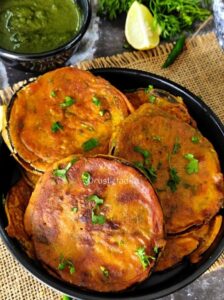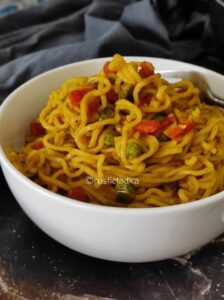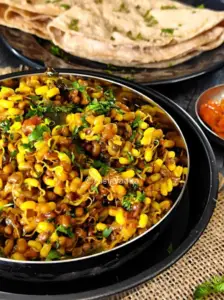Farali Kachori is a popular Indian Fasting (Vrat / Upvas) recipe made with coconut filling that is stuffed in potato covering.
This is a vegetarian, vegan, gluten-free, no onion no garlic (satvik) dish.
The recipe that I have shared here is made using freshly grated coconut along with basic spices & herbs.
These kachori are also called farali pattice, farali aloo pattice or upvasach pattice (upvasache padharth).
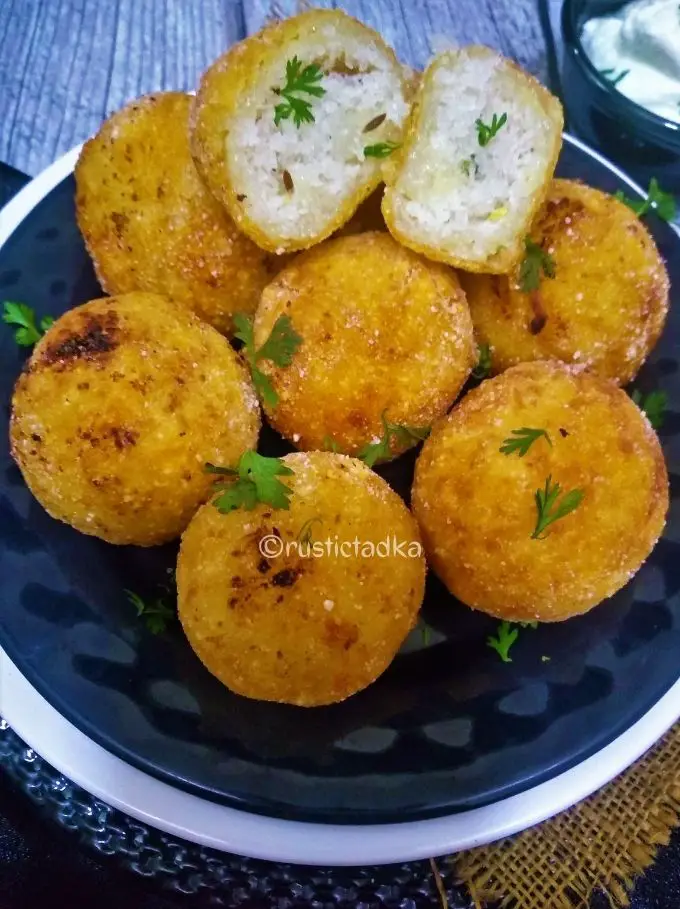
[convertkit form=7110706]
About Farali Kachori
Farali kachori is an easy deep-fried mildly spiced stuffed kachori made using boiled potatoes and flavourful sweet-tangy subtle coconut filling.
The sweetness naturally comes with the coconut and spiciness from the green chilles that are added to it.
Apart from green chillies, no other spices are used in making this recipe
You will find farali kachori served in mithai (sweets) shops and even in restaurants across Mumbai and Gujarat. These are served along with curds or with peanut chutney.
Apart from being eaten during a fast, these delicious kachoris can be made for evening snacks and can be served along with spicy coriander chutney or tomato ketchup. These are immensely loved by kids.
To make this farali kachori, the recipe is divided into two parts.
First is the filling that is made using freshly grated coconut along with cashew nuts, raisins, and green chilies.
The second part consists of making the covering of the kachori by using boiled potatoes along with binding flour such as sabudana or sago flour, and arrowroot flour.
Sabudna flour or arrowroot helps potatoes to bind well and does not break or separate in oil while frying.
When you are not making this kachori for vrat (fasting) you can make use of cornstarch or rice flour and relish it with a cup of hot tea or coffee!! It tastes absolutely delicious!
At home, we make this kachori as a traditional feast during Ekadashi and sometimes during Anagriki.
While making for vrat, you may add sendha namak (pink salt) instead of regular table salt.
Many times we also make use of coarsely grounded peanut powder instead of using coconut. The addition of peanut powder gives a nice depth of texture to this kachori.
Apart from making this kachori, another popular snack for fast is farali bhel which is made with potato chivda & sabudana chivda is also mostly prepared in many households during the fast.
ingredients
Potatoes – We will need boiled, peeled and grated potatoes for the covering of this kachori.
Coconut – We will require freshly scrapped coconut which makes the base for the stuffing.
Herbs & Spices – To give a nice depth of flavour to the stuffing we will need, cumin seeds to give a nice nutty bite to this kachori and green chilles for that hint of spice.
Nuts & Raisins – Adding cashew nuts and raisins enhances the taste of these kachoris.
Seasoning – To give a mild tanginess, we will add some lemon juice. To season I have added table salt and some sugar. You may also use senda namak (rock salt) when making for vrat.
Flours – We will also require sabudana flour for coating the kachoris to get that crispy exterior. Making sabudana flour at home is very easy. You will need to roast the sabudana first and then when cooled, grind to a powder.
Oil – We will need oil to deep fry these farali kachoris.
Frequently Asked Questions
What other flours can I use for the covering instead of sabudana?
Rajgira (amaranth) flour, singhara (water chestnut) or a combination of these flour can be used instead of sabudana.
Can Farali Kachori be made in an air fryer?
Yes, Preheat the air fryer to 375°F (190°C). Lightly brush the kachoris with oil and cook for 15-20 minutes. Turn them halfway until they are golden brown and crispy from all sides.
Can I add vegetables to this filling?
Yes, if you intend to make them for non-fasting days, you can add vegetables like carrots, peas for added nutrition and flavour. Make sure to cook the veggies before adding to the stuffing.
How can I make farali kachori healthier?
To make these kachori healthier, you may bake them or air-fry them instead of deep frying.
How to avoid the filling coming out of the kachori when frying?
Make sure to seal the edges properly by pressing the ends together firmly. You may also apply some water to moisten the edges which will help them stick together better.
Which oil is used to fry Farali Kachori?
Oil that are suitable for high-temperature frying like sunflower oil, peanut oil or vegetable oil can be used.
Variations
You can use sweet potatoes instead of regular potatoes which gives a slightly sweeter taste and is quite nutritious.
You may also use roughly crushed peanuts for the filling instead of coconut or a combination of both.
If making for non-fasting day, you may also add vegetables like boiled peas, carrots or beans.
Serving Suggestions
Serve Farali kachoris as a snack with peanut-coconut chutney, tamarind chutney or with plain curd.
These also makes perfect evening tea-time snack. You may also serve them with coriander chutney or ketchup for non-fasting days.
These can also be served for family get-togethers and festive gatherings.
Storage Options
These farali kachoris are best served fresh. In case you have leftovers, store them in an airtight container at room temperature. They stay good for 2 days. Make sure to cool them before storing them in the container and reheat them before serving.
Related Recipes
No Onion No Garlic (Satvik) Recipes
More vrat (Fasting) Recipes
Rajgira Puri (Amaranth Puri), Sabudana Vada
Step-by-step How to make Farali Pattice
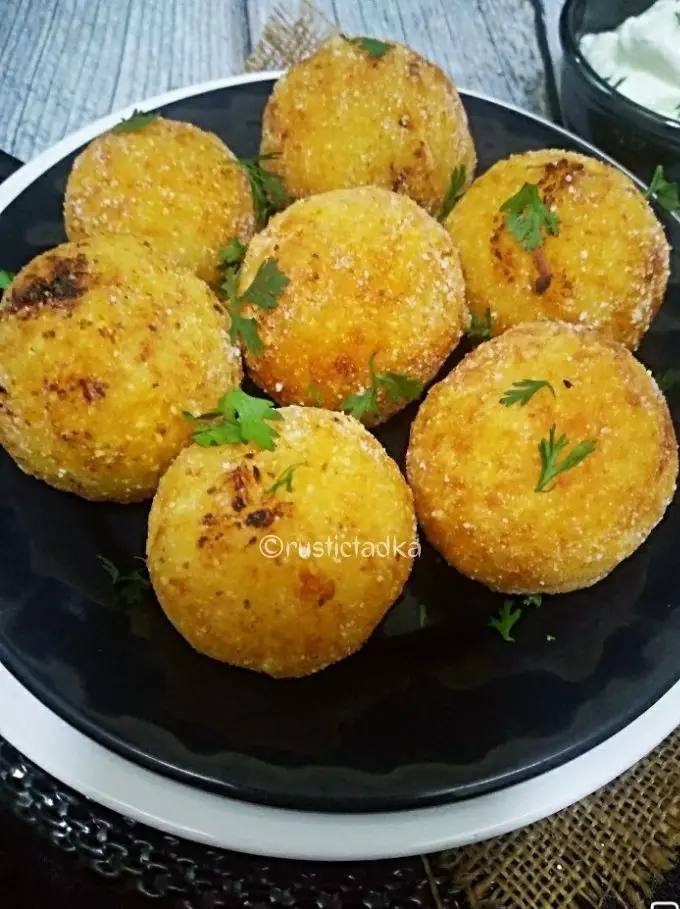
First, let’s see how to make homemade sabudana flour for this recipe.
- In a thick bottom pan, add the sabuana pearls and roast them on a medium flame for about 10-15 minutes.
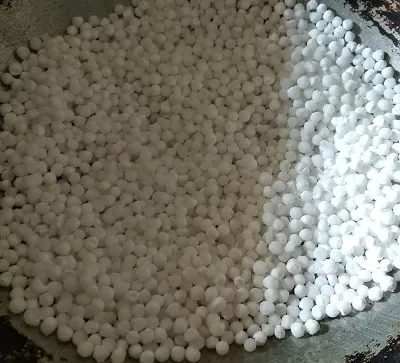
- Cool them and grind them to a powder.
- Our homemade sabudana flour is ready to use.
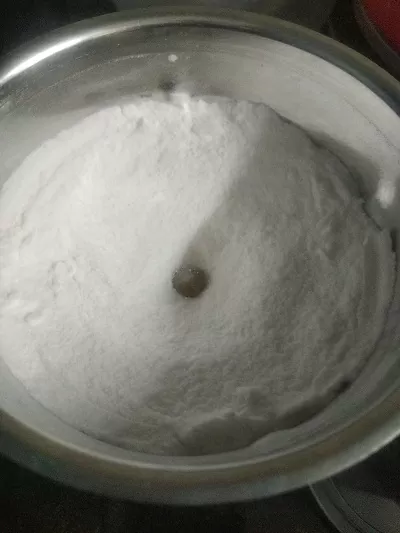
For Stuffing:
- In a mixing bowl, add freshly scrapped coconut, golden raisins, cashew nuts, salt, sugar, and green chilli. Mix well.
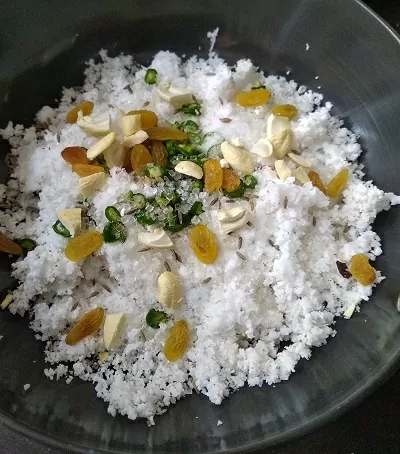
- Saute this mixture so that all the ingredients get well incorporated together and the sugar melts.
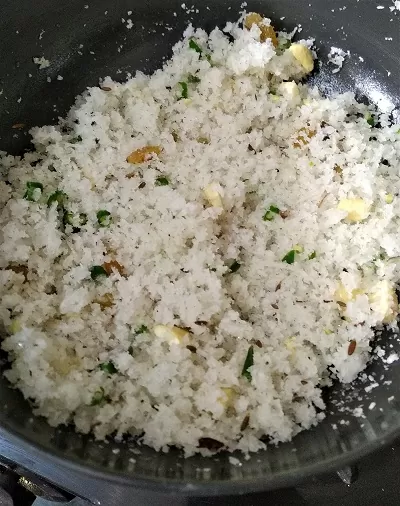
- Transfer the stuffing onto a plate and let it cool.
- Once cooled to lukewarm or room temperature, add lemon juice and finely chopped coriander leaves. Coriander leaves are optional here as some do not eat them during fast.
For Outer Covering:
- In a bowl, add boiled, peeled and grated potatoes, sabudana flour and salt. Mix well.
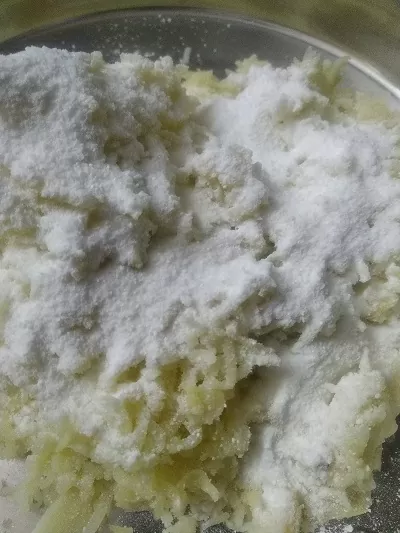
- Make a stiff dough of potato and sabudana flour. Do not add any water to it.
Important: Here you need to eyeball the flour that you are using as it totally depends on the moisture of the potatoes. The measurement mentioned above is what I ended up adding.
- You may use arrowroot flour, varai flour, rajgira flour if you do not have sabudana flour.
- Let’s make the kachoris.
- Grease your palm with a little oil. Take a golf ball-sized portion of the potato mixture and make a cavity (dent) in the centre.
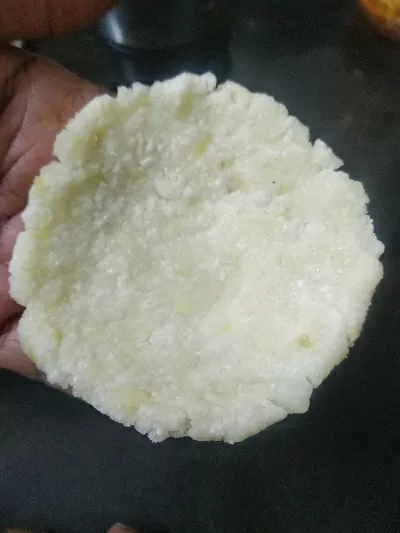
- Place a spoonful of stuffing in it. Seal the stuffing with potato mixture. Make sure to seal all the sides. Do the same with the remaining kachoris.
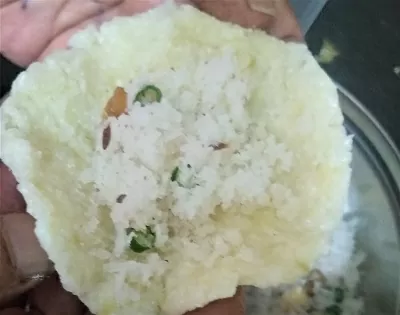
- Our kachoris are ready for deep frying.
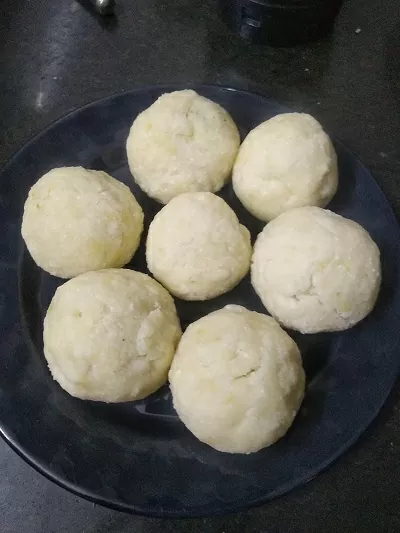
- On a plate spread some sabudana flour and roll the kachoris in it. This method adds that extra crunch to this farali kachori.
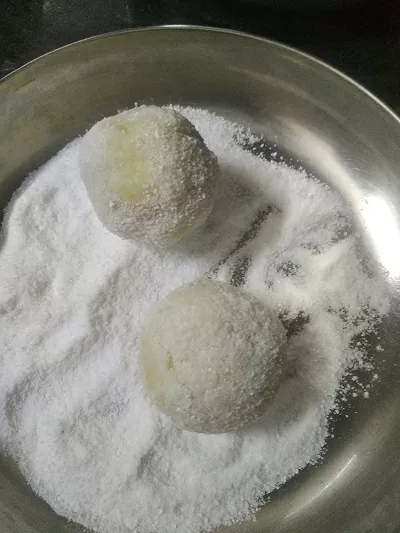
- Deep fry the kachoris in hot oil till golden brown. Fry them on a medium flame.
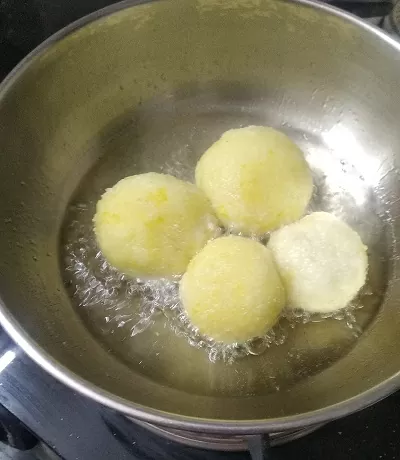
- Transfer the kachoris onto an absorbent paper to drain excess oil.
- Farali kachori is ready.
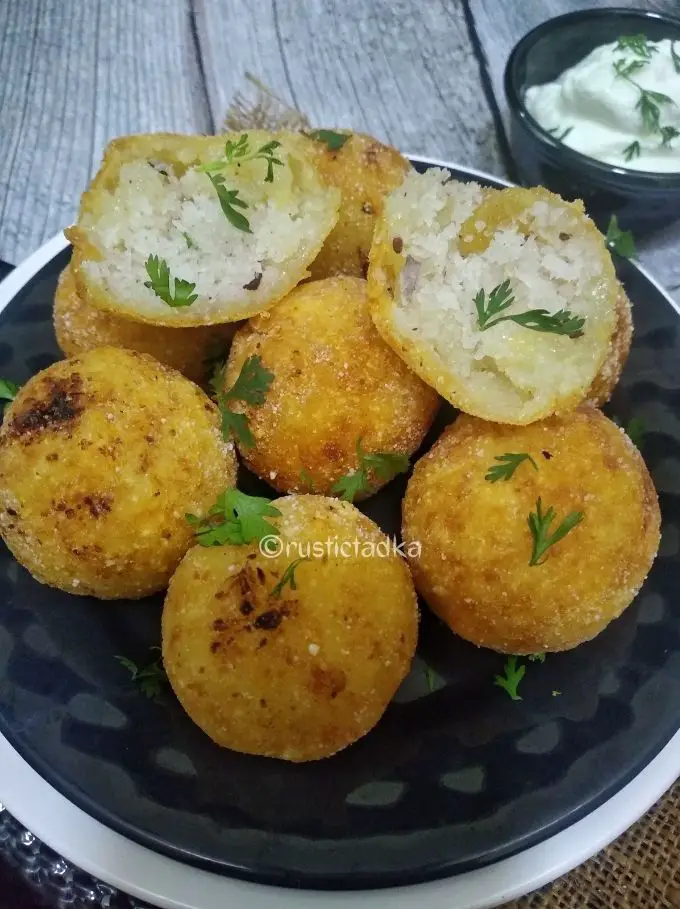
- Serve hot with curd, coconut chutney or peanut chutney.
Note:
1. If you can’t get or do not have fresh coconut, you may use dedicated coconut as well. The taste will change a bit.
2. If you are not making these kachoris for fast then you can use cornstarch or rice flour to add in the potato mixture instead of sabudana flour (sago flour)
3. You may also use peanut powder instead of coconut.
Join “Easy Indian Vegetarian & Vegan Recipes” on Facebook & be a part of our community.
If you like recipes like these, let’s connect on YouTube, Instagram & Facebook.
Thank you for stopping by, I would really love to know your thoughts on this recipe.
Also, do check out my Lifestyle Blog eralivine.com if interested.
Recipe Card
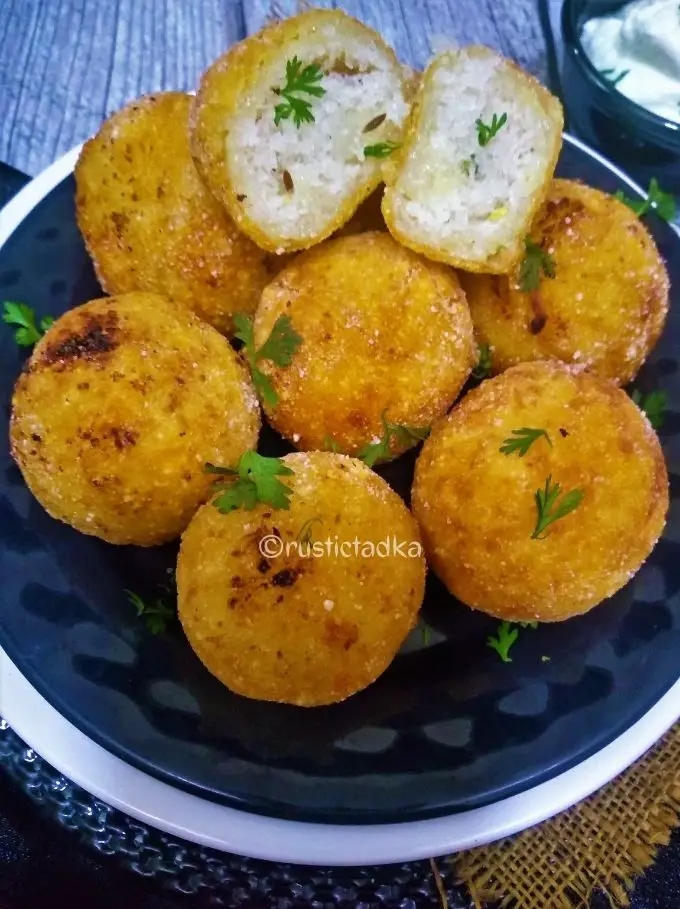
Farali Kachori | Farali Pattice | vrat Ke Pattice
Ingredients
Method
- In a thick bottom pan, add the sabuana pearls and roast them on a medium flame for about 10-15 minutes.
- Cool them and grind them to a powder.
- Homemade sabudana flour is ready to use.
- In a mixing bowl, add freshly scrapped coconut, golden raisins, cashew nuts, salt, sugar, and green chilli. Mix well.
- Saute this mixture so that all the ingredients get well incorporated together and the sugar melts.
- Transfer the stuffing onto a plate and let it cool.
- Once cooled to lukewarm or room temperature, add lemon juice and finely chopped coriander leaves. Coriander leaves are optional here as some do not eat them during fast.
- In a bowl, add boiled, peeled and grated potatoes, sabudana flour and salt. Mix well.
- Make a stiff dough of potato and sabudana flour. Do not add any water to it.
- Important: Here you need to eyeball the flour that you are using as it totally depends on the moisture of the potatoes. The measurement mentioned above is what I ended up adding.
- Grease your palm with a little oil. Take a golf ball-sized portion of the potato mixture and make a cavity (dent) in the centre.
- Place a spoonful of stuffing in it. Seal the stuffing with potato mixture. Make sure to seal all the sides. Do the same with the remaining kachoris.
- Kachoris are ready for deep frying.
- On a plate spread some sabudana flour and roll the kachoris in it. This method adds that extra crunch to this farali kachori.
- Deep fry the kachoris in hot oil till golden brown. Fry them on a medium flame.
- Transfer the kachoris onto an absorbent paper to drain excess oil.
- Farali kachori is ready.
- Serve hot with curd, coconut chutney or peanut chutney.

